Noise along the Potomac
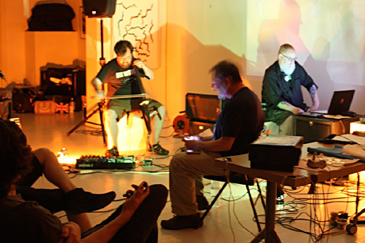
Experimental Music in the Washington D.C. Area
by Daniel Barbiero
(December 2015)
The Washington D.C. area is home to a community of experimental musicians and sound artists who, while existing largely below both the surface and notice of the area's official culture, have created an eclectic field for the exploration of sounds in relation to other sounds and to the environment. While "experimental" is difficult if not impossible to define in relation to music, it is nevertheless a term with an established history of use, and all or nearly all of the artists discussed here would accept it to describe their own work if for none other than expedient reasons. For present purposes, "experimental music" isn't meant to name a genre but rather to characterize a set of practices shaped by an attitude of curiosity often informed by a DIY spirit; these practices run the gamut from playing pitched sounds on conventional instruments to creating harsh noise with electronics and non-instruments, and much else in between. The backgrounds of the individuals involved are varied, but virtually none are professional musicians or affiliated with institutions. All are highly committed to their art, which exists as a marginal yet vivid presence in such venues as art galleries, former industrial spaces, basements--and occasionally, the Kennedy Center.
What follows is a set of impressions organized into loose aesthetic groupings. A caveat: I write as a participant, not as a disinterested observer. The artists covered here are friends, colleagues and in very many cases collaborators. A second caveat: music deriving from the tradition of free jazz improvisation, while a significant presence within D.C. area experimentalism, won't be covered here; it would require an account all of its own.
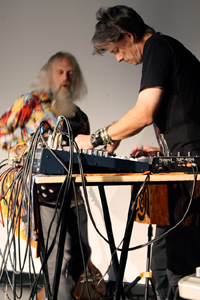
There is no dominant aesthetic among D.C. area experimentalists, but there is a strong vein of what might be called an improvised audio brutalism. Many of the artists use pedals, mixer, computers and hacked and other electronic devices to improvise sound blocks projecting into audio space, often in an aggressive manner. Their typically angular, hard-edged, industrially-timbred sounds are subject to various formal manipulations: juxtaposition, isolation, stratification and are frequently arranged as layered slabs analogous to the concrete masses forming the facades of brutalist buildings. A focus on texture via density, attenuated "pitchiness," spatialization and cumulative structures is a significant factor for these artists, for whom sound is something approaching a primordial entity. Jeff Surak's solo electronic work (performed in the past under the name Violet) and his trio work with guitarist Anthony Pirog and cellist Janel Leppin; Jeff Carey's computer-based, gesturally-driven sound synthesis; and Jeff Bagato's Tone Ghosting electronics project all share an interest in the exploration of dense and sometimes abrasive sounds, frequently at high volumes. The heterogeneous array of turntables, pedals, manipulated instruments and other contemporary intonarumori of J.S. Adams' BLK w Bear project point directly to a conscious engagement with a neo-Futurist noise aesthetic filtered through recent and contemporary technologies.

There is an acoustic variant of this kind of raw, sound-based experimentation--an acoustic musique concrete, as it were. Although less frequently encountered than its electronic counterpart, it does turn up among musicians using expanded techniques, detuning and/or preparations on acoustic instruments. Gary Rouzer's performances on cello, solo and joined by Paolo Valladolid on prepared viola; Surak's scordatura and prepared zither; and Layne Garrett's unorthodox use of acoustic guitar can, when listened to with eyes closed, effect a type of acousmatic trompe l'oreille that obscures the how and what of sound production.
Within the larger practice of electronic experimentation, drone is a significant subset. A number of artists specialize in constructing sound masses centered on a single pitch or a limited number of pitches which are held constant while other parameters, most often timbre and dynamics, undergo slow or rapid mutation. Superficially akin to ambient music, this type of drone is potentially hypnotic but with an often serrated edge. Chris Videll, who performs and releases music as Tag Cloud, creates dronescapes using analogue electronics, pedals, a Micro Brute synthesizer, and other apparatus. Guitarist Jeff Barsky, through his Insect Factory project, layers tones and mostly static harmonies into trance-provoking fields of sound. Chester Hawkins--the artist formerly known as Blue Sausage Infant--also pursues trance music with keyboard-based synthesizers and more recently with an analogue modular synthesizer.
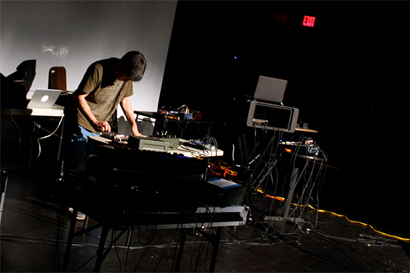
Related to drone, and often overlapping with it, is a kind of melodic constructivism--a music of layered primary sounds based on pitch relationships and tonal centers real and apparent. Generally less harsh than the heavier drone music, melodic constructivism retains a formal resemblance to drone's texturally-centered aesthetic while employing a measure of harmonic change. Luke Stewart's improvisations for six-string bass guitar and effects are rooted in harmonies derived from open-string harmonics, their strata made up of complex relationships between pitches and emergent harmonies. Although quite capable of working with harsh drones, guitarist Beau Finley, both in solo work and in collaboration on the Rind project with cellist Doug Stailey, also builds consonant soundscapes out of gradually developing melodic phrases and shifting harmonic aggregates.
Some artists work with musical readymades--everyday, ostensibly non-musical objects that are scraped, rubbed, struck, shaken and otherwise manipulated and often amplified. Rouzer, working as Amptext, performs live sets using cardboard, Styrofoam, kitchen utensils and pre-recorded sounds; his cello, too, often seems to be a readymade--just another object in a world of objects, albeit one that just happens to be a string instrument. Amanda Huron, who plays with Garrett in the duo Weed Tree, supplements her drum kit with an array of metal and other objects that serve her as a kind of ad hoc, minimal gamelan; percussionist Nate Scheible also integrates miscellaneous objects into his kit, often drawing a frictive, rough-hewn sound from them. Keith Sinzinger, aka Fast Forty, deploys a perpetually changing battery of toys, instruments acquired from flea markets and at curbside, and outright junk hacked and crafted into sound sources of his own invention.
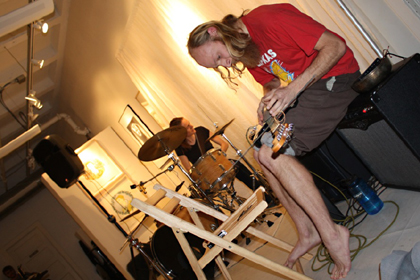
As Sinzinger's work shows, these readymades are only a step or two removed from self-made, DIY instruments, which represent something resembling a more self-conscious or refined stage of evolution for ostensibly non-musical objects. The transformation of mundane materials into functioning instruments can bring about remarkable sounds--Garrett's fabrication at the 2014 Sonic Circuits Festival of a large, outdoor string instrument out of Styrofoam boxes, scrap metal sheets and wire is exemplary, as is Bagato's creation of a "stone-age synthesizer" out of metal springs mounted in a plastic box rigged with contact microphones.
These sonic readymades and inventions occupy a conceptually ambiguous space defined by a double recontextualization: on the one hand, of the everyday object, distorted, modified or misused as it may be, as musical; and on the other hand of the musical sound as being in principle indistinguishable from the everyday sound. In the process these artists step over a fence perceived to have been pulled down by John Cage, fluxus, and others.
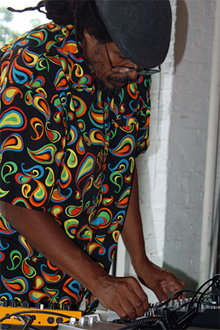
Closely akin to the conceptual appeal of found objects is the appeal of found sounds as raw material for more encompassing, deliberate works analogous to Merzbau collages made of detritus. To a greater or lesser extent, many D.C. area experimental artists incorporate found sounds--field recordings, Dictaphone tapes, cast-off commercially recorded LPs and the like--into their work, combining them in real-time sound collages. These might take the form of Surak's Dictaphone interventions in live performances (his own and others'), BLK with Bear's integration of recorded performances with live ensemble work or Leppin's use of LP's in tandem with voice or improvisations on cello, to pick three examples. For some artists, collage is the major organizing principle for their performances. Thomas Stanley creates real-time collages out of recorded sounds, live instruments and electronic manipulation; Bobby Hill (who often collaborates with Stanley in Mind Over Matter Music Over Mind) collages and recontextualizes sounds through turntablism; the Stylus Turntable Ensemble is, as its name announces, is a group built around sound collage, the Califone record player being its staple instrument.
One of the hallmarks of postwar experimentalism was the intermedia work--the work that crossed boundaries of field, discipline or medium. Several D.C. area artists have found this peculiar neither/nor, both/and area to be fertile. A number have integrated visual arts with sound: filmmaker and field phonographer Chris Lynn has presented his silent super 8 films to live improvised soundtracks; Surak has provided live sound for the films of Sylvia Schedelbauer; BLK with Bear and others have accompanied performances with projected images. Others have combined music with performance art and dance. Zach Mason, playing as Soft Pieces, has reimagined live electronics as the soundtrack of a larger work of interactive body art involving the audience. Both Scheible and Rouzer are frequent participants in improvisational dance performances, and some of Rouzer's solo sets have included elements of theater. In live performances and on recordings the sui generis Music from the Film derive a hallucinatory sense of narrative from allusions to horror and low-budget films, talk radio, and the more outrageous type of tabloid newspaper. More soberly but no less surreally, Irish-born composer/performer Sarah O'Halloran explores dreamlike narrative as a structuring element for live performance, building aural semi-fictions out of uncanny stories embedded in electronic soundscapes.
The continuing use of performance art represents a variety of reappropriation and renewal of gestures associated with a previous generation of experimental artists. To an extent this entails taking the vocabulary of X and recontextualizing it in the rhetoric of Y; in the D.C. experimental community, such appropriation extends beyond allusions to genre (or inter-genre) to encompass compositional structure and even instrumentation.
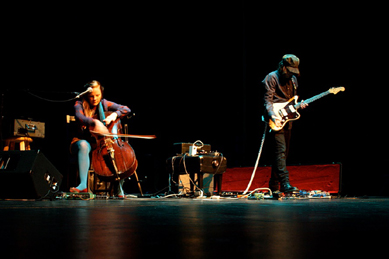
Working together and as solo artists, Leppin and Pirog appropriate and subvert the song structures and harmonic expectations of recent rock and jazz, often taking disparate aspects of genre conventions and making them into wholly original combines. In a similar manner, Gillis, Hawkins and Videll offer highly individualized reworkings of the undulating layers and slow cyclicality of kosmische music and 1970's Berlin electronics; the guitar ensemble Boat Burning take the standard instrumentation and other aspects of rock convention and redirect them to new and sometimes quite different ends.
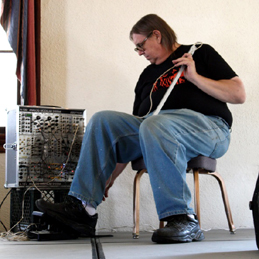
Recent years have seen a reawakening of interest in analogue electronics; at least one D.C. area experimentalist, Dave Vosh, has been committed to exploring analogue modular synthesis for a period predating the current vogue. Taking inspiration from the historical, post-Darmstadt avant-garde, Vosh leverages the timbral lexicon of classic postwar electronic music and arranges it within a stripped-down syntax that stands alone or serves as the framework for collaboration with other electronics artists and even acoustic musicians. Christine Paluch, who performs under the name Praxis Cat, also employs analogue modular synthesis, frequently supplemented with loops and effects. An even earlier electronic instrument, the theremin, is the preferred vehicle for Art Harrison and Amber Dunleavy. The classic avant-garde trope of electronic amplification and manipulation of acoustic instruments' pitch, timbre and dynamics is also refigured through decidedly post-avant-garde sensibilities in the duo work of Curt and Dani Seiss and the solo work of Erica Benay Fallin.
This last point is a reminder that experimentalism always takes place within, and inevitably with reference to, a situation, an always-already-there. Call it precedent, or an interpretive tradition, or a constituted field of praxis--it's a frame, and one to be bent, twisted and occasionally broken altogether. And it's a situation that D.C. area experimental musicians confront with engagement and ingenuity.
All images by Chester Hawkins/Intangible Arts